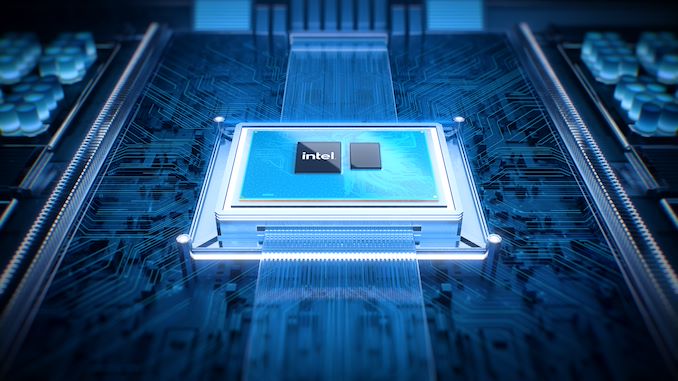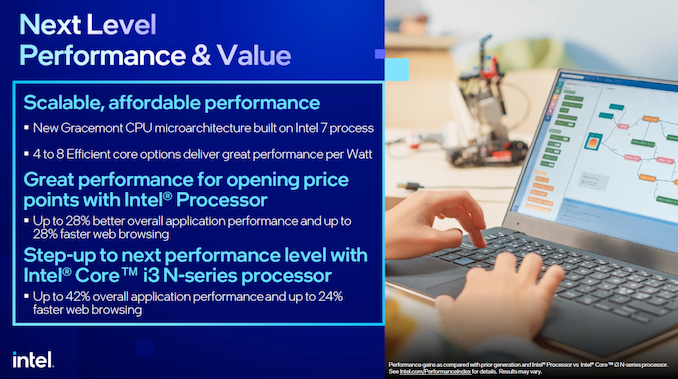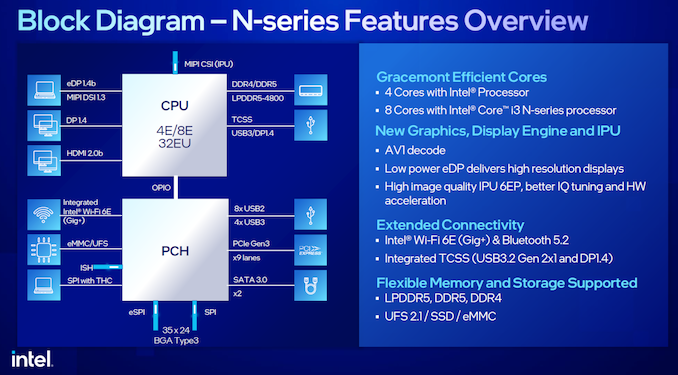Intel Announces Gracemont-based N-Series Processors For Entry-Level Mobile and Desktop Systems
by Gavin Bonshor on January 3, 2023 10:30 AM EST
Although Intel's 13th Gen Core mobile announcement tends to steal the limelight away from many of its other product announcements, Intel has also announced four new SKUs from its N-series of processors. Representing the entry-level, Intel's latest N-series processor for mobile and desktop (codenamed Alder Lake-N), replacing Intel's Tremont architecture-based Jasper Lake platform. Alongside up to 8 CPU cores, these new low-end SoCs include Wi-Fi 6E connectivity, GNA 3.0 background noise suppression, and integrates IPU and MIPI camera support rolled into one solution. This makes it a suitable series of products designed for video conferencing and high-end wireless connectivity for entry-level notebooks, Chromebooks, and low-power users.
Based around the same Gracemont CPU microarchitecture Intel uses for efficiency (E) cores in its 12th and 13th Gen Core processors, Intel's N-Series processors are designed for low-powered and affordable slimline notebooks and desktops, where efficiency is vital. Intel is also claiming double-digit performance gains with the latest quad-core Intel Inside N200 processor compared to the previous series, with 28% better overall application performance and up to 28% gains in web browsing performance.
Stepping up to the Core i3 N-series processors, Intel is claiming gains of up to 42% in overall application performance, which is advantageous from an efficiency and performance per watt perspective. Not only is the N-series the entry-level processors designed for budget Windows notebooks and Chromebooks, but Intel's claims look to surpass its previous Jasper Lake models, such as the N6000, out of the water. With either eight or four Gracemont cores, the same efficiency (E) core is used in Intel's 13/12th Gen Core series families.
Regarding features, Intel has plenty up its sleeve as it promises advantageous video conferencing capabilities due to its integral Image Processing Unit (IPU) and MIPI camera interface, along with dynamic noise suppression for microphones. With noise suppression handy for video conference calls and eliminating background noise, it uses a low-powered Gaussian and Neural Accelerator (GNA 3.0) technology to achieve this.
Focusing on connectivity, the N-series can accommodate up to four USB 3 and eight USB 2 and has nine PCIe 3.0 lanes available for devices and controllers. By proxy, the Intel N-series now also benefits from Intel's WI-Fi 6E CNVi with BT 5.2 device connectivity, along with USB 3.2 Gen 2 and DisplayPort 1.4 support.
| Intel N300/200/100-Series (Gracemont Core on Intel 7) | |||||||
| AnandTech | Cores C/T |
E-Core Base |
E-Core Turbo |
L3 Cache (MB) |
Processor Graphics |
Memory Support |
Turbo W |
| i3-N305 | 8/8 | ? | 3800 | 6 | 32 EU | DDR5-4800 DDR4-3200 |
15 |
| i3-N300 | 8/8 | ? | 3800 | 6 | 32 EU | DDR5-4800 DDR4-3200 |
7 |
| IP N200 | 4/4 | ? | 3700 | 6 | 32 EU | DDR5-4800 DDR4-3200 |
6 |
| IP N100 | 4/4 | ? | 3400 | 6 | 24 EU | DDR5-4800 DDR4-3200 |
6 |
The Core i3 N-series CPUs come with eight cores and eight threads, versus the four cores and four threads of the Intel Processor N200 and N100 chips. The Core i3-N305 is the top-tier SKU for the entry-level series, with eight Gracemont cores that can turbo up to 3.8 GHz and a maximum turbo TDP of 15 W. Memory support is similar to its 13th Gen Core family with DDR5-4800, LPDDR5-4800, and DDR4-3200 support across all four SKUs.
The Core i3-N300 has similar specifications, including 32 EU graphics cores and 6 MB of L3 cache, but with just over half the power budget available with a maximum turbo TDP of 7 W. Focusing on the two entry-level Intel Processor branded chips, the IP-N200 and IP-N100 both include four Gracemont cores and four threads, along with 6 MB of L3 cache. Both feature a turbo TDP of 6 W, although the IP-N200 hs an E-core turbo of 3.7 GHz, with 32 EU graphics core units, while the entry-level N100 has a maximum clock speed of 3.4 GHz and just 24 EU graphics cores.
Intel has specified that it has over 50 OEM designs ready to go with its N-series processors, including partnerships with Windows OEMs such as HP, ASUS, and Lenovo, as well as partnerships with ChromeOS and leading Chromebooks. It hasn't been stated when the N-series will start filtering into retail models, but this is expected to be soon.












31 Comments
View All Comments
Samus - Tuesday, January 3, 2023 - link
Powerful 7-watt 8-core x86 CPU. Finally getting competitive with ARM.chris.london - Tuesday, January 3, 2023 - link
It costs $309 though.Samus - Tuesday, January 3, 2023 - link
Ouch. Yeah, Intel still being Intel...IntelUser2000 - Wednesday, January 4, 2023 - link
And you believe that reflects reality at all?The previous gen top dog N6000 sold in $350 canadian dollar notebooks. That's not possible if the CPU is actually anywhere more than $100, nevermind $300.
name99 - Tuesday, January 3, 2023 - link
Not necessarily.All we know is the peak power, not how well it handles “most of the time”, either fully idle, or in ramping up to full speed and back.
For the sorts of designs that uses these chips, most battery life is about life when you’re not using the device (but it’s still alive, checking networks and so on).
lazybum131 - Wednesday, January 4, 2023 - link
I'm optimistic that they're at least as good as Amber Lake-Y for battery life. The Surface Go 3 is hobbling along with that in the i3-10100y - 8th-gen Core architecture with only 2c/4t. The N300 with 8c/8t with similar clockspeeds and updated memory should blow that outta the water. A potential Surface Go 4 would be a big step up even without battery life improvements.lopri - Wednesday, January 4, 2023 - link
6 cores at 3.8 GHz = 7W? I will believe it when I see it. Or is it "Up to" 3.8 GHz?dontlistentome - Wednesday, January 4, 2023 - link
7w is TDP. That will boost to 30w+ at times. My 12th gen laptop will idle at 3w with the screen off but is nearly 40w when ragging just the 8 E cores. These will probably be less than that, but think 30w when it's busy.PeachNCream - Wednesday, January 4, 2023 - link
I hope its not quite so horrible since the table lists the wattage while under "Turbo" implying that 6-15W is possibly peak consumption which implies passive cooling is realistic.thestryker - Tuesday, January 3, 2023 - link
I'm mostly curious what sort of NUC style boxes will be put together using these. They appear to be using one of the newer IGP designs (based on connectivity/AV1 decode I'm guessing TGL) so they could make for a great low power HTPC type system.